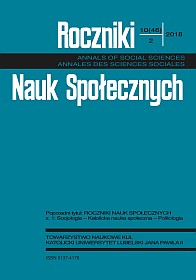Hatha-Yoga in Higher Education
Abstract
This paper deals with the problem of adaptation of hatha-yoga practice to the system of higher education. There are some problems with including yoga into the curricula of higher education institutions, and these are described with respect mainly to the USA and Polish context.
The body has been almost excluded from programs of teaching. There is a large gap between the theory and practice. However, the body could be an active subject (actant) in learning and perceiving the reality. It could be used to teach philosophy, psychology, sociology and management, and other courses. Students could achieve embodied knowledge, and not only the opportunity of gaining an intellectual knowledge coming from and through the mind. I am a sociologist and I describe my experiences with including yoga in teaching sociological and psychological subjects in a Polish University. The results from auto-reports of students show that by hatha-yoga practice students could see the connection between the body and mind concerning the production of emotions, which could be important in teaching of techniques of stress reduction, sociology of emotions, psychology of emotions, philosophy of body, management, coaching or other subjects where emotions and the body are important factors of activity.
References
Cohen, J.B. 2006. The missing body – Yoga and higher education. The Journal of the Assembly for Expanded Perspectives in Learning, 12 (winter), 14-24.
Conboy, L.A., Noggle, J.J., Frey, J.L., Kudesia, R.S., Khalsa, Sat Bir S. 2013. Qualitative evaluation of a high school yoga program: feasibility and perceived benefits. Explore. The Journal of Science and Healing, 9(3), 171-180.
Cooley, Ch. 1922. Human Nature and the Social Order. New York: Charles Scribner’s Sons.
Daut, C. 2016. A Case for More Yoga on Campus: Yoga as Self-Care for Higher Education and Student Affairs Professionals. The Vermont Connection, 37(6), 48-60.
Dewey, J. 1938. Experience & Education. New York, NY: Kappa Delta Pi.
Douglass, L. 2010. Yoga in the public schools: Diversity, democracy and the use of critical thinking in educational debates. Religion & Education, 37 (2), 162-169.
Douglass, L. 2011. Yoga in Higher Education: North American Educators and the Use of Yoga as Pedagogy, dissertation for the degree of Philosophy, Lesley University. (http://ir.flo.org)
Douglass, L. 2011a. Yoga as a counternarrative: American higher education rethinks difference and interdependency. Pedagogy, Pluralism and Practice, (15), 1-35.
Felver, J.C., Butzer, B., Olson, K.J., Smith, I.M., Khalsa, Sat Bir S. 2015. Yoga in public school improves adolescent mood and affect. Contemporary School Psychology, 19(3), 184-192.
Helberg, N., Heyes, C., and Rohel, J. 2009. Thinking through the body: Yoga Philosophy, and Physical Education. Teaching Philosophy, 32(3), 263-284.
Iyengar, B.K.S. 1983. Light on Pranayama. Pranayama Dipika. London: Unwin Paperbacks.
Iyengar, B.K.S. 2002. The Tree of Yoga. Boston: Shambhala.
Iyengar, B.K.S. 2005. The Illustrated Light on Yoga. New Delhi: HarperCollins Publishers India & The India Today Group.
Iyengar, B.K.S. 2005a. The Illustrated Light on Yoga. New Delhi: HarperCollins Publishers India & The India Today Group.
Iyengar, B.K.S. 2005b. Light on Life. The Yoga Journey to Wholeness, Inner Peace, and Ultimate Freedom. Pennsylvania: Rodale.
Khalsa, Sat Bir S. and Butzer, B. 2016. Yoga in school settings: a research review. Annals of the New York Academy of Sciences, 1373(1), 45-55.
Konecki, K.T. 2015. Is the Body the Temple of the Soul? Modern Yoga Practice as a Psychosocial Phenomenon. Kraków: Jagiellonian University Press.
Konecki, K.T. 2017. Stanting in Public Places: An Ethno-Zenic Experiment Aimed at Developing the Sociological Imagination and More Besides. Czech Sociological Review, 6, 881-901.
Leder, D. 1990. The Absent Body. Chicago: University of Chicago Press.
Morley, J. 2001. Inspiration and expiration: Yoga practice through Merleau-Ponty’s phenomenology of the body. Philosophy East and West, 51 (Jan), 1; ProQuest Central.
Orr, D. 2002. The uses of mindfulness in anti-oppressive pedagogies: philosophy and praxis. Canadian Journal of Education, 27(4), 477-497.
Pagis, M. 2010. From Abstract Concepts to Experiential Knowledge: Embodying Enlightenment in a Meditation Center. Qualitative Sociology, 33, 469-489.
Scheff, T. 1990. Microsociology. Discourse, Emotion, and Social Structure. Chicago: The University Press.
Scheff, T. 2014. Role-taking, Emotion and The Two Selves. Canadian Journal of Sociology/Cahiers Canadiens de Sociologie, 39 (3), 315-329.
Singleton, M. 2010. Yoga Body. The Origin of Modern Posture Practice. Oxford: Oxford University Press.
Singleton, M. 2010b. Translations, Belief Frameworks and Modern Yoga Practice. The Magazine of Yoga, http://themagazineofyoga.com/blog/2010/10/12/conversation-mark-singleton/ [September 04, 2011].
Singleton, M. 2010c. Yoga’s Greater Truth. Yoga Journal, http://www.yogajournal.com/wisdom/2610 [September 03, 2011].
Singleton, M. 2013. Transnational Exchange and the Genesis of Modern Postural Yoga. Pp. 37-56 in: Yoga Travelling. Bodily Practice in Transcultural Perspective, edited B. Hauser. Heidelberg, New York, Dordrecht, London: Springer.
Sjoman, N. 1996. The Yoga Tradition of the Mysore Palace. New Delhi: Abhinav Publications.
Copyright (c) 2018 Roczniki Nauk Społecznych

This work is licensed under a Creative Commons Attribution-NonCommercial-NoDerivatives 4.0 International License.


